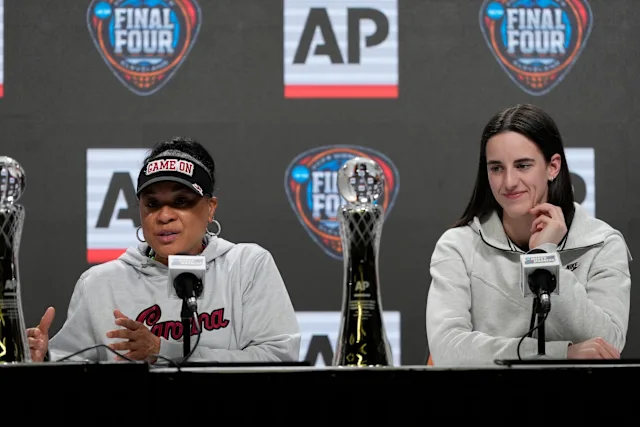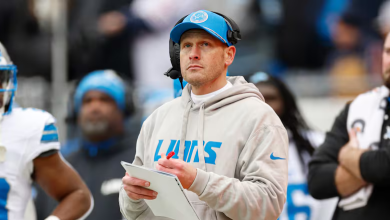Dawn Staley comments on the Caitlin Clark-Angel Reese rivalry, urging new fans drawn by Clark to appreciate the broader talent and depth across all of women’s basketball.

The Caitlin Clark–Angel Reese rivalry has captivated sports fans across the nation, becoming one of the most talked-about storylines in modern women’s basketball. Their on-court battles, brimming with passion, skill, and competitive fire, have drawn millions of new eyes to the sport. But as the conversation continues to swirl around these two stars, South Carolina head coach Dawn Staley has offered a refreshing and necessary perspective: she appreciates the attention but urges fans to broaden their focus and embrace the full depth of talent within the women’s game.
In her thoughtful commentary, Staley didn’t downplay the significance of the Clark-Reese rivalry. Instead, she used the moment to elevate the sport as a whole, highlighting the array of talent that deserves recognition beyond the headlines. As one of the most respected voices in basketball — and someone who’s played, coached, and advocated at every level — Staley’s message carries weight.
Let’s take a deeper look at what this rivalry represents, what Dawn Staley’s perspective reveals, and why her call for a broader appreciation of the game could shape the future of women’s basketball.
The Rise of a Rivalry: Clark vs. Reese
The rivalry between Iowa’s Caitlin Clark and LSU’s Angel Reese is a blend of individual excellence, competitive fire, and national intrigue. Clark, with her long-range shooting and high basketball IQ, has become synonymous with highlight-reel offense. Reese, known for her physical dominance, rebounding prowess, and unapologetic swagger, represents an equally potent force.
Their clash in the 2023 NCAA Championship game set the stage for one of the most electric matchups in women’s college basketball history. Millions tuned in. Social media exploded. The moment transcended the sport. Their rematch in 2024 only added to the drama, and the conversation around both players reached mainstream audiences far beyond traditional basketball circles.
For many, Caitlin Clark became the entry point into women’s basketball. Her Steph Curry-like range and undeniable charisma made her a magnet for fans. But with that spotlight also came polarization — debates over sportsmanship, race, media bias, and the coverage disparities between players like Clark and Reese.
Dawn Staley: “Let This Be the Beginning, Not the End”
As attention around the rivalry grew, so too did the tendency of some fans and media outlets to frame the entirety of women’s basketball around two players. That’s where Dawn Staley stepped in.
In a press conference during the NCAA Tournament, Staley acknowledged the excitement that Clark and Reese bring to the game. But more importantly, she made a plea to new fans:
“If Caitlin Clark brought you to women’s basketball, that’s great. But now that you’re here, look around. There are other great players. There are other great teams. This is a deep, beautiful, competitive sport.”
Staley’s message wasn’t just about diversifying fan interest — it was about honoring the growth, complexity, and richness of women’s basketball. For her, this is a defining moment. The sport is experiencing a surge in viewership, coverage, and cultural relevance, and it’s essential that the attention lifts the whole game, not just a few faces.
The Bigger Picture: A League of Stars
Coach Staley’s comments underline a crucial truth: the Caitlin Clark–Angel Reese rivalry is only one part of a much larger mosaic.
Consider the following players and narratives:
- Paige Bueckers (UConn): A dynamic scorer and leader who overcame injury to return to form, Bueckers was once the face of college hoops and continues to be a generational talent.
- Kamilla Cardoso (South Carolina): The Brazilian center dominated on both ends of the court and played a vital role in South Carolina’s championship runs.
- JuJu Watkins (USC): The freshman phenom lit up scoreboards all season and could very well be the next superstar on the national stage.
- Hailey Van Lith (LSU): Known for her competitive edge and gritty play, Van Lith brings fire and experience wherever she plays.
And that’s just scratching the surface. Women’s basketball is filled with talented athletes making waves both in college and at the professional level in the WNBA.
By urging fans to explore beyond Clark and Reese, Staley is championing a deeper engagement — one that fosters long-term investment in the sport.
Media’s Role: Focus, Fairness, and Framing
Another angle Staley’s comments implicitly address is the role of media in shaping narratives. While it’s natural for standout athletes to become focal points, an over-concentration on a single rivalry can narrow the lens through which the sport is viewed.
Too often, stories in women’s basketball are presented in binary terms: hero vs. villain, humble vs. brash, or white vs. Black — dynamics that subtly (and sometimes not-so-subtly) affect how players are covered and discussed.
Staley, who has long spoken out on issues of race, equity, and representation, understands how media framing can uplift or undercut athletes. Her call to “look around” is also a push for more nuanced, inclusive storytelling — one that recognizes the complexity and diversity of today’s players.
Growing the Game: Why Now Matters
The explosion of interest in women’s basketball is no fluke. It’s the product of decades of hard work, incremental progress, and athletes who have relentlessly pushed the boundaries. But now, with TV ratings soaring, arenas filling up, and NIL deals empowering players financially, the sport stands on the edge of something even bigger.
Staley’s vision is clear: If fans who discovered the sport through Clark stay and begin to support players across the board, women’s basketball can finally receive the consistent national attention it deserves. That means:
- More televised games across conferences
- Larger investments in facilities and coaching
- Increased NIL and endorsement opportunities for a wider pool of players
- Stronger grassroots support for girls’ basketball programs
The Caitlin Clark-Angel Reese rivalry might be the spark, but for the fire to spread, it needs fuel in the form of broader interest and equitable support.
A Coach, A Leader, A Voice of the Game
Dawn Staley has never shied away from speaking the truth — even when it’s uncomfortable. Whether advocating for her players, speaking on systemic inequities, or setting a standard of excellence on the court, she continues to be a cornerstone of women’s basketball.
Staley understands the balance between celebrating the stars and building a strong foundation for the whole game. Her success with South Carolina, including multiple Final Four appearances and national championships, stems from this philosophy: team over individual, substance over flash.
In encouraging fans to expand their horizons, she’s ensuring that the future of the sport is not built on fleeting attention but lasting commitment.
Beyond the Rivalry, A Movement
The Caitlin Clark–Angel Reese rivalry has electrified women’s basketball, bringing it to the forefront of the sports conversation. Their battles will be remembered for years to come and rightly so. But as Dawn Staley reminds us, the game is bigger than any two players.
Her call to action is simple yet profound: Stay curious. Watch more teams. Learn more names. Cheer for excellence wherever you see it.
Because women’s basketball isn’t just about rivalry — it’s about resilience, teamwork, innovation, and inspiration. With the sport surging in popularity, now is the perfect time for fans to embrace the full picture.
And when they do, they’ll find a game rich with stories, stars, and soul.
Let me know if you’d like this article adapted for a specific publication, condensed into an op-ed or social media post, or expanded with quotes from Staley or other players.









